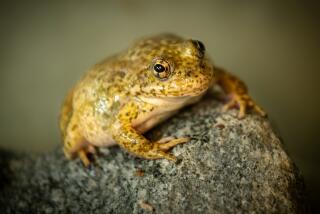Fires in California Spell Both Death and Renewal for Wildlife
A lone condor soars above the fire-scarred hillside, zeroing in on a charred rabbit carcass on the naked black ground. It swoops down for a meal, one of many on a day when the hunting is easy.
Miles away, a dying fish gasps for oxygen under a thick blanket of ash and soot covering the surface of the stream.
In a mountain canyon, a pair of deer nibble on nutritious green buds sprouting from a burned trunk.
The scenes of death and renewal are being repeated across California, where more than 1,500 wildfires have both hurt and helped dozens of species of wild animals.
“There are two ways to look at it,” Bruce Elliott, California Department of Forestry wildlife biologist, said. “There’s the short term and the long term.”
Hundreds Perish
The short term means hundreds of animals--most of them rabbits, gophers, rats, lizards and snakes--perished in crackling flames that have charred nearly 400,000 acres since June 27.
The long-term view is more positive, with the brush and forests beginning to grow back, more lush than before, and the strongest and smartest animals thriving.
This month, dozens of wildlife specialists from the state Forestry Department, state Department of Fish and Game and U.S. Forest Service are hiking through the charred hillsides to survey the fire damage and make rehabilitation recommendations.
Most of the programs will be geared toward reseeding hillsides with 1 million pounds of fast-growing rye grass in the fall to prevent winter mud slides onto highways and homes.
Part of Natural Cycle
The wild animals will be left to adapt on their own, much as they have done after centuries of wildfires that are as much a part of California’s natural cycle as rain.
For the small rodents and reptiles that were smart enough or lucky enough to survive the smoke and flames, the next few weeks will mean either being eaten by hungry predators or reproducing quickly and flourishing on newly sprouted shrubs and grasses.
Other swifter species like deer, cougars, bears and birds were able to outrun the flames and flee to safety. Many animals, especially deer, face a slow death from malnutrition or disease as they are crowded into unburned areas, however.
Elliott said underfed does will lose fetuses to spontaneous abortions or stillbirths, and many of their fawns will die shortly after birth.
Survivors Will Return
But those that survive will return to the burned-out area and flourish.
“Within a week, new shoots start coming out of old plants,” state Fish and Game spokesman Jack White said. “Within a year, it can handle a tremendously increased deer population.”
The fire has cleared away tough old shrubs and grasses that have lost their nutritional value with age, and animals will thrive on the new growth high in calories. With the thick underbrush gone, animals will be able to graze over larger areas and become healthier.
“Does will start having twins instead of one,” state Fish and Game wildlife specialist Jim Lidberg said. “The bottom line is there will be more than before the fire. I’ll bet my life on it.”
The fire is also good news for the endangered condor, whose habitat is in the rugged mountains of Ventura, Santa Barbara and San Luis Obispo counties. The flames did not reach the vultures’ rocky roosts, and there will be plenty of carrion for them to eat, Elliott said.
But for the endangered bighorn sheep species in the San Jacinto Mountains, wildfires may have tragic results by destroying their favorite shrub species, many of which are supplanted by grasses the sheep won’t eat.
“I don’t think any sheep got hurt in the fire, but the long-term effects could be bad,” Steve Loe, wildlife biologist for the Forest Service, said.
Trout, bass and salmon will also be hard hit this winter as rain storms wash debris and dirt into mountain streams and lakes throughout the state, biologists said. The ash and dirt will suffocate the fish as well as their eggs and many anglers may see a decline in the fisheries for 15 to 20 years, Lidberg said.
Predators Won’t Suffer
Mountain lions, bobcats and bears will not suffer much, however, being able to hunt over wide areas. Nor will they be forced to feed on livestock or prey on humans, biologists said.
Department of Forestry spokesman White said fire officials have been trying for years to convince the public of the need for controlled burns to prevent destructive wildfires and to help new brush grow for the wildlife.
But controlled burns have become more difficult and more dangerous as people build more and more homes in the midst of thickly vegetated hillsides and canyons.
“The Indians themselves set fires deliberately,” White said. “They understood the need.
“Sooner or later, something like lightning is going to have to consume all that fuel.”
More to Read
Sign up for Essential California
The most important California stories and recommendations in your inbox every morning.
You may occasionally receive promotional content from the Los Angeles Times.










